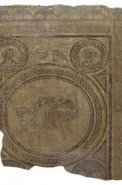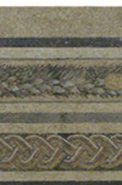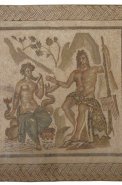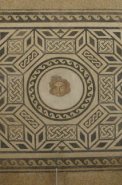
Hall of Mosaics Audiodescription.
The entrance to the Hall of Mosaics is located in the gallery where the Roman sarcophagus and the bust of Seneca are. Here several rows of chairs are laid out. The balconies on the right open out to a view of the so-called "Ladies' Patio". At the other end of the hall there is a square-base dais which exhibits a different style to the rest of the room.
This room is next to Alcázar's North Wall and is located on top of the vaults of the Doña Leonor Baths. The hall has a rectangular plan and it is covered by a vault of lunettes and transverse arches which are decorated with geometric patterns typical of 18th century Córdoba. A key part of the decoration of this hall which should be mentioned are the Roman mosaics, dating from 2nd and 3rd centuries and discovered during construction work in the remodelling of Corredera Square. These lavish mosaics adorn the walls of the room, giving it its name. The hall is divided in two by an arch, separating the main hall area from the dais. This area is covered by a dome supported by pendentives. The dome is crowned by a cupola. The back wall features an alcove with a rectangular floor plan and an arched ceiling. The large tapestry on display in the alcove shows the emblems of the Court of Castile and the city of Cordoba.
This room was originally constructed to be the Inquisition Chapel where the autos-da-fé would be officiated, but then underwent renovation in the 18th century. Subsequently, this building became a prison after the Inquisition reached its end in 1820. Today it is named Salón de los Mosaicos (Hall of Mosaics) and it is used by the town council for the official public events and civil marriage ceremonies.
Press the Play buttons to access a speech version of the description or the audiodescription for visually impaired.
Click in Audiodescription to access to its text version.

Alcazar of the Christian Monarchs. Plaza Campo Santo de los Mártires s/n. 14004 Córdoba
2011 Ayto. de Córdoba. All rights reserved. Legal Advice









